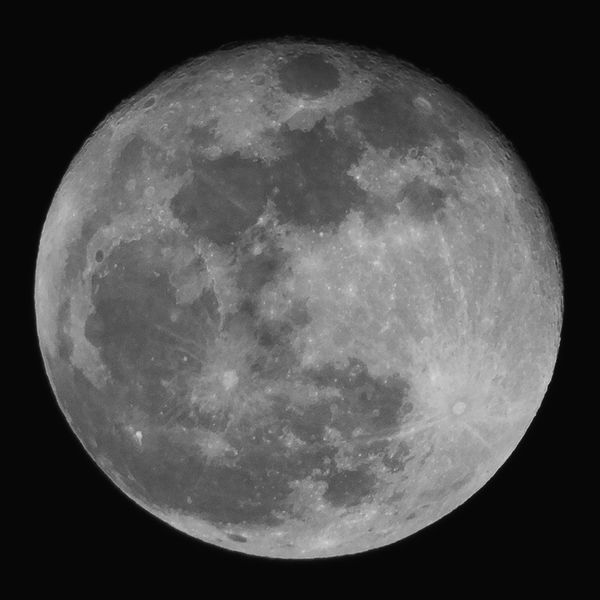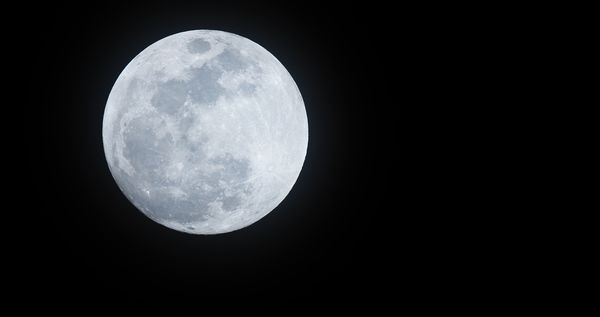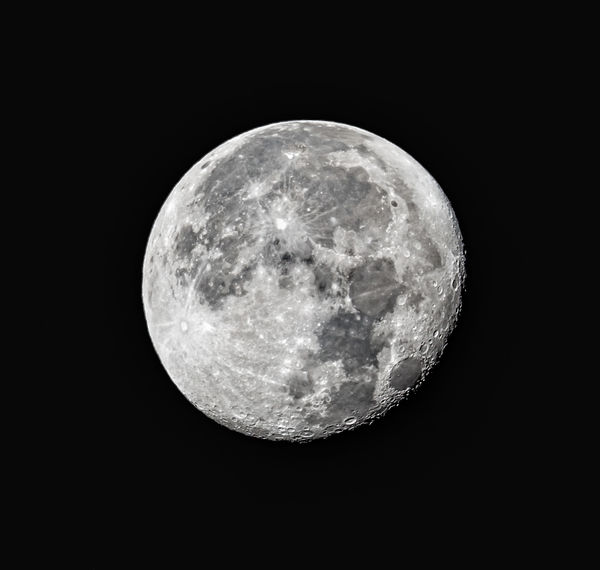A point that's often overlooked when discussing how to shoot a full moon
Oct 27, 2018 12:05:59 #
With a large variety of suggested settings, seemingly different for every respondent, I feel that one point being overlooked is the fact that different combinations of numbers can equal the same exposure.
If your moon is a featureless white blob, it might simply be over-exposure and you merely have to make a darker exposure to achieve success. But, do you understand that you should not randomly change your settings? Consider these points:
1. Depth of field is not relevant if you are shooting just the moon itself, so set your aperture to what you have learned gives best image quality with your lens (click for information on lens diffraction)
2. Shutter speed is relevant because the moon is moving and you or your camera may be also.
3. ISO is relevant because many cameras produce better quality images with lower ISO.
I would appreciate discussion that furthers the understanding of why we choose the settings we have suggested to our moon-shooting newbies Many thanks!
Many thanks!
If your moon is a featureless white blob, it might simply be over-exposure and you merely have to make a darker exposure to achieve success. But, do you understand that you should not randomly change your settings? Consider these points:
1. Depth of field is not relevant if you are shooting just the moon itself, so set your aperture to what you have learned gives best image quality with your lens (click for information on lens diffraction)
2. Shutter speed is relevant because the moon is moving and you or your camera may be also.
3. ISO is relevant because many cameras produce better quality images with lower ISO.
I would appreciate discussion that furthers the understanding of why we choose the settings we have suggested to our moon-shooting newbies
 Many thanks!
Many thanks!Oct 27, 2018 12:16:55 #
Oct 27, 2018 12:25:39 #
I use iso-100, lowest available f-stop (lens wide open) and change the shutter speed until I get a good contrast of light and dark areas in the live view lcd screen. I shoot hand held and raw. This always seems to work for me with every camera and lens. Then I crop in Photoshop and tweak the contrast, shadows and highlights. It seems the longer the focal length the better. The attached was taken with the Coolpix B700. The focal length is listed as 361mm, though with the small sensor the equivalent focal length is 1440mm. Because it's the moon, the small sensor's lack of EQ and color depth doesn't matter. The shot was taken at iso-100, f6.5, 1/500 sec.
Oct 27, 2018 12:25:48 #
Just use Sunny 16. The Moon is in full Sunlight. Works for me. - Dave
Oct 27, 2018 12:33:38 #
Linda From Maine wrote:
With a large variety of suggested settings, seemin... (show quote)
Why?
Got real tired of that word with little kids.

Why I choose 100-400mm L MII with 2X MIII at f5.6, ISO 100 and 1/125 sec. is that is a good starting point.
The 100-400mm L MII is the same quality with or without the converter so I get an 800mm lens equivalent. (1,280mm view on my APSC camera)
It gets a good exposure and from there, then I bracket with aperture/shutter settings to get a brighter or darker moon. Not below 1/30th of a sec. because the moon is moving pretty quickly and that magnification lets you see it move.
There is no perfect exposure in this range so look and see what appeals to you.
Also a darker moon can then replace a washed out moon in a composite photo of say a building at night that needed a longer exposure etc.
So bottom line start with the sunny 16 rule then adjust your camera to suit your taste and desire. It is all free so experimenting only costs a few minutes.
Oct 27, 2018 12:39:49 #
JFCoupe
Loc: Kent, Washington
Linda From Maine wrote:
With a large variety of suggested settings, seemin... (show quote)
I think you points are very good and will be very helpful to many photographers. I would like to add additional comments to the discussion of good moon photography.
I have frequently photographed full moons from my yard in Kent, WA (15 miles from Seattle) and been disappointed in the overall sharpness of the images. (Both with a Canon full frame and 300 mm f2.8 L with 2x TC and more recently an Olympus EM1 MK II and Panasonic 100-400mm lens.
In late September I was in Alaska on a polar bear photography trip and in a stop over in Fairbanks had an opportunity to go about 30 miles outside Fairbanks to shoot Aurora images. The moon was about half full that night and I took a few images of it. I was amazed at how sharp my images were of the moon compared to images shot at home. This leads me to two issues I have not come to a firm conclusion on:
1. Impact of air pollution on sharp moon images
2. Impact of light pollution on sharp moon images.
I think my next step will be to get further outside the city at the next cloudless, full moon and see if light or air pollution are really factors.
Thanks,
Oct 27, 2018 12:41:43 #
wilsondl2 wrote:
Just use Sunny 16. The Moon is in full Sunlight. Works for me. - Dave
Never use this rule. It is totally obsolete. And how would you use it at night? Spot meter the moon. All you care about is how bright the moon itself is. You will be surprised how bright it is.
Oct 27, 2018 12:44:22 #
Select a focal length that allows you to fill up the frame. That varies with the camera body and how high the moon is in the sky. Forget about all this specific advice that says this or that lens or focal length. Likewise about exposure. Use what does the job at hand.
Oct 27, 2018 12:47:45 #
Linda,
You've made some great points. Here is an image I made of the blue moon on January 30, 2018 using my D7000 and Nikkor 200-500mm lens. I set it at the full 500mm focal length, even though it might have been a bit sharper if I'd shot at less than the extreme magnification (e.g., 400mm). ISO of 110 was nearly the lowest possible (ISO 100 for that body). F/8 is quite sharp with this lens. At those settings, I needed to add a little exposure compensation for a proper exposure (+1.33 ev). This was an experiment in focus stacking, so I took 8 shots in all. At shutter speed of 1/100, it was possible to take 8 shots with minimal movement of the moon. Using the focus stacking tools in Affinity Photo was quick and easy, aligning the 8 images as layers and combining the eight layers. The result is quite sharp with almost no noise. It also got rid of the light glow around the moon that I believe is caused by the moonlight passing through the Earth's atmosphere. I started with a couple of shots, studied the results, then adjusted my settings until I was pleased with the exposure before taking my 8 shots for stacking. Just an example of what you were discussing. jak
You've made some great points. Here is an image I made of the blue moon on January 30, 2018 using my D7000 and Nikkor 200-500mm lens. I set it at the full 500mm focal length, even though it might have been a bit sharper if I'd shot at less than the extreme magnification (e.g., 400mm). ISO of 110 was nearly the lowest possible (ISO 100 for that body). F/8 is quite sharp with this lens. At those settings, I needed to add a little exposure compensation for a proper exposure (+1.33 ev). This was an experiment in focus stacking, so I took 8 shots in all. At shutter speed of 1/100, it was possible to take 8 shots with minimal movement of the moon. Using the focus stacking tools in Affinity Photo was quick and easy, aligning the 8 images as layers and combining the eight layers. The result is quite sharp with almost no noise. It also got rid of the light glow around the moon that I believe is caused by the moonlight passing through the Earth's atmosphere. I started with a couple of shots, studied the results, then adjusted my settings until I was pleased with the exposure before taking my 8 shots for stacking. Just an example of what you were discussing. jak
Oct 27, 2018 12:58:34 #
abc1234 wrote:
Never use this rule. It is totally obsolete. And how would you use it at night? Spot meter the moon. All you care about is how bright the moon itself is. You will be surprised how bright it is.
Why is it obsolete?
Did things change with the moon?
It gets me there still just fine.
Oct 27, 2018 13:09:00 #
thanks again linda for posting such great topics i learn alot from you and jerry also 



Oct 27, 2018 13:09:33 #
larryepage
Loc: North Texas area
A big plus is a location with dry, clear, air at all levels of the atmosphere. Moisture and atmospheric instability are the biggest detriments to sharpness. Clouds in the area indicate the presence of both moisture and instability. Instability means that the air is "different" at different levels, leading to all sorts of possible distortion from refraction at layer boundaries and other sorts of ugliness. But if it gets too cold, ice crystals, especially at higher levels, can also cause problems for a number of reasons including, yes, diffraction. This can even be visible when a hazy circle is visible around the moon.
One change I made after learning what lunar material really looks like is that I now make images that are significantly darker than the ones I used to make. If you have a chance to see actual lunar material, you will be surprised to find that most of it that has been returned to earth looks surprisingly like an 18% gray card...some of it maybe a stop lighter. It is not white at all. We perceive the moon as nearly white because of its contrast to blue sky when we see it in the daytime or with our eyes dark-adjusted when we see it at night. There is absolutely nothing artistically wrong with portraying the moon this way, but that is not the way it really is. The most accurate images are those that include a lot of medium gray.
And while some may get good results by spot metering the moon, I do not recommend doing that, because the full moon covers an angle of only somewhere between 0.4 and 0.5 degrees. Most really good standalone spot meters cover 1 or 2 degrees, meaning that even they are including a big blob of dark sky when taking a reading. Most in-camera spot meters are even wider than that. Anything short of a 400mm lens on a full frame calera is going to include dark sky even in a spot meter reading.
The moon does move through the sky. It moves about 14.4 degrees per hour (360/25, if you are counting.) That means that it moves its own diameter about every 1.7 - 2.1 minutes. At a shutter speed of 1/100 second, that is about 1/12,000 of its diameter. So if it is filling your eyepiece, that works out to probably half a pixel for a D850. For a more typical framing or smaller sensor, it would be somewhat less. Summary: Use 1/200 or a little faster and don't worry about it too much.
One change I made after learning what lunar material really looks like is that I now make images that are significantly darker than the ones I used to make. If you have a chance to see actual lunar material, you will be surprised to find that most of it that has been returned to earth looks surprisingly like an 18% gray card...some of it maybe a stop lighter. It is not white at all. We perceive the moon as nearly white because of its contrast to blue sky when we see it in the daytime or with our eyes dark-adjusted when we see it at night. There is absolutely nothing artistically wrong with portraying the moon this way, but that is not the way it really is. The most accurate images are those that include a lot of medium gray.
And while some may get good results by spot metering the moon, I do not recommend doing that, because the full moon covers an angle of only somewhere between 0.4 and 0.5 degrees. Most really good standalone spot meters cover 1 or 2 degrees, meaning that even they are including a big blob of dark sky when taking a reading. Most in-camera spot meters are even wider than that. Anything short of a 400mm lens on a full frame calera is going to include dark sky even in a spot meter reading.
The moon does move through the sky. It moves about 14.4 degrees per hour (360/25, if you are counting.) That means that it moves its own diameter about every 1.7 - 2.1 minutes. At a shutter speed of 1/100 second, that is about 1/12,000 of its diameter. So if it is filling your eyepiece, that works out to probably half a pixel for a D850. For a more typical framing or smaller sensor, it would be somewhat less. Summary: Use 1/200 or a little faster and don't worry about it too much.
Oct 27, 2018 13:24:36 #
JFCoupe wrote:
I think you points are very good and will be very ... (show quote)
A full moon is flatly lit - so it will lack the shadows and contrast that help define crisp details. Even an almost full moon has better contrast than the full moon.
Though it is a bit of an urban legend, no "Sunny 16" here. Maybe Sunny 11 - nothing has changed with the moon - it's just that Sunny 16 doesn't and never did apply -

1/200, F8, ISO 100. D800 with a Sigma 150-600 Sport @600mm - hand held. One night after full moon. Taken in NYC - so much for light pollution, spot metering, etc. It is not possible to "fill the frame" with even a 600mm lens - so forget that advice.
Oct 27, 2018 13:29:20 #
Architect1776 wrote:
Why is it obsolete?
Did things change with the moon?
It gets me there still just fine.
Did things change with the moon?
It gets me there still just fine.
It works by serendipity. Why obsolete? If you have a digital camera and are like most people, you judge exposure by what is on the screen and histogram. The meter helps you get close to what looks good. Whether you stick to that old saw or a meter, do you not look at the shot on your viewer?
Just what is the basis of that rule? How was it validated? Is it still valid? You tell us.
Do things change with the moon? Yes. For daylight, you have a range of brightness. For the moon, it is all basically black and white with a little gray detail in the moon. That brightness range is small compared with the overall moon against a black sky. Do you agree?
The bottom line is that you will use what you want. I, for one, will stick to the meter and the screen on the back of the camera. Works for me. May or may not work for you.
Oct 27, 2018 13:32:10 #
Gene51 wrote:
A full moon is flatly lit - so it will lack the shadows and contrast that help define crisp details. Even an almost full moon has better contrast than the full moon.
Though it is a bit of an urban legend, no "Sunny 16" here. Maybe Sunny 11
1/200, F8, ISO 100. D800 with a Sigma 150-600 Sport - hand held. One night after full moon.
Though it is a bit of an urban legend, no "Sunny 16" here. Maybe Sunny 11

1/200, F8, ISO 100. D800 with a Sigma 150-600 Sport - hand held. One night after full moon.
Gene, I suspect this would be sharper if you used a tripod. Did you have image stabilization on? What was the focal length? As you have said in the past, this is a very heavy lens so do you think you can hold it steady enough?
If you want to reply, then register here. Registration is free and your account is created instantly, so you can post right away.











